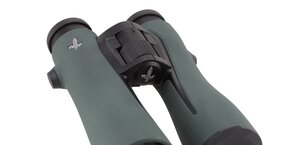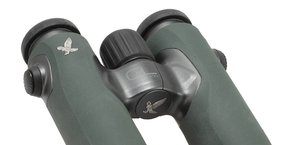Docter Nobilem 8x56 B/GA
All the Nobilem series binoculars are heavy, big instruments equipped with large prisms. They consist of a two-element objective lens and a four-element eyepiece (as we assume from the advertising leaflet’s schematic picture). All air-to-glass surfaces are covered by high class antireflection multi-layer coatings. The binoculars are made of aluminum (newest version made of magnesium composites), generously covered by high quality rubber. They are watertight.
The binoculars come with centrally regulated sharpness and a 30-year-long guarantee.
| Magnification | Lens diameter | Angular field of view | Prisms | Eye relief | Weight | Price |
|---|---|---|---|---|---|---|
| 8 | 56 | 110/1000(6.3o) | BaK-4/Porro | 17.5 mm | 1350 g | 3490 PLN |
Summary
Pros:
- sensational transmission,
- very low chromatic aberration,
- slight coma,
- negligible astigmatism,
- low distortion,
- sharp image almost to the edge of the field,
- low brightness loss at the field of view borders,
- solid housing,
- very good whiteness reproduction,
- excellent blackening and cleanliness inside the inner tubes,
- perfectly circular exit pupils,
- excellent prisms and coatings,
- long guarantee.
Cons:
- strange position of the tripod exit,
- loose-fitting objective caps.
 |
The Docter Nobilem 8x56 is a set of binoculars which review must be almost full of superlatives. The Analytik Jena continues the good traditions of the Carl Zeiss Jena company and the Nobilem series is an excellent example of it. The 8x56 model is characterized by an outstanding transmission, large field of view, very low astigmatism and chromatic aberration minimal even at the edges of the field. The latter advantage is especially worth emphasizing as the Docters have had one of the whitest image of all binoculars tested here so far. In such a white image any aberration flaws would be clearly visible but the Docters simply didn’t have any of them. The usage of the huge Porro system prisms is also worth emphasizing, as it resulted in a clear, bright image, free from any brightness losses at the edges.
 |
The Docter’s result is so good that it is difficult to find any disadvantages. In principle, you must pay for a decent field of view, splendid transmission and lack of vignetting because you have to deal with huge prisms, significant weight and bulky dimensions of the binoculars. The constructional solution of the tripod exit, which was put on the side of the barrel, not on the central axis which is a standard position, surprises us. The rubber armour of the binoculars makes the access very difficult and the huge weight of the instrument suggest some problems with the usage. Objective caps are a disadvantage when it comes to the barrel construction – they are too loose and they are tethered to the inner tubes on thin rubber straps that don’t look as if they had a long life-span. All these flaws are not very bothersome, though, and the price, twice lower than in the case of the Swarovski, Zeiss or Leica models which are comparable in terms of quality, is very appealing. Nevertheless you must spend as much as about 1000 USD anyway. For this sum, though, you get excellent binoculars for the rest of your life (the 30-year-long guarantee persuades us of it very efficiently).
At the very end we show the Docter’s transmission graph which is an example to be followed by all other companies. No other binoculars, tested by us, have had a nicer graph so far.
 |














